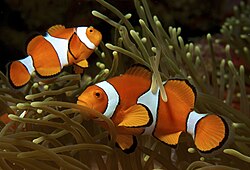
Back Amphiprioninae Afrikaans سمكة المهرج Arabic سمكة المهرج ARZ Pexe payasu AST Klovnfisk Danish Pés pajàs EML Klaŭnfiŝo Esperanto Amphiprioninae Spanish دلقکماهی Persian Poisson-clown French
| Clownfish | |
|---|---|

| |
| Amphiprion ocellaris | |
| Scientific classification | |
| Domain: | Eukaryota |
| Kingdom: | Animalia |
| Phylum: | Chordata |
| Class: | Actinopterygii |
| Order: | Blenniiformes |
| Family: | Pomacentridae |
| Subfamily: | Amphiprioninae Allen, 1975 |
| Genus: | Amphiprion Bloch & Schneider, 1801 |
| Synonyms | |
| |
Clownfishes or anemonefishes are saltwater fishes in the genus Amphiprion within the subfamily Amphiprioninae. They are classified as damselfish within the family Pomacentridae. Clownfishes are found in the warm and tropical waters of the Indo-Pacific, inhabiting mainly coral reefs. They have a distinctive colouration typically consisting of white vertical bars on a red, orange, yellow, brown or black background. Clownfish have developed a mutualistic symbiotic relationship with sea anemones, which they rely on for shelter and protection from predators. In turn, clownfish will protect the anemone from anemone-eating fish, as well as clean and fan them, and attract photosynthetic zooxanthellae via waste.
Clownfish are omnivorous and mostly feed on planktonic food. They live in groups consisting of a breeding female and male, along with some non-breeding individuals. Clownfish have a size-based dominance hierarchy with the female ranking at the top, followed by the male and then the largest non-breeder and so on. When the female disappears, the male changes sex and takes her place while the others move up the hierarchy. During reproduction, the female deposits eggs on a rock near their anemone and the male fertilises them. After hatching,clownfish disperse into the open ocean as larvae, and eventually settle on the bottom and search for an anemone host as juveniles.
The recognisable colour patterns and social nature of clownfish have contributed to their popularity. They are featured in the Disney/Pixar film Finding Nemo and are sought after in the aquarium trade. Amphiprion ocellaris is the most popular species and among the most commonly traded reef fish. Many captive clownfish have been taken from the wild and this has led to their decline. Clownfish are more numerous in marine protected areas, where collecting is forbidden. Other threats to populations include global warming which causes ocean warming and acidification.
© MMXXIII Rich X Search. We shall prevail. All rights reserved. Rich X Search